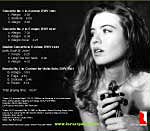| RELATED LINKS |

Lara's Bach CD 

Lara's Gypsy CD 
|

| Free poster with every CD. click photo to enlarge (92KB) |
check out the unconventional artwork 
|

|

LINER NOTES
Bach's first instrument was the violin. His son, C.P.E. Bach, stated that his father "in his youth and well into old age, played the violin with a clear penetrating sound". Bach took his first lessons on the instrument at the age of six and his mastery of it enabled him to acquire his first post. He eventually became the Concertmaster in Weimar, a court with a rich and discerning taste in violin virtuosity. Although he is better remembered in this era as presumably the greatest ever organist, his surviving works for the violin are a rich testament to his proficiency and genius. This recording shows Bach the violinist as well as Bach the composer.
The violin concertos were written somewhere in the 1720's-1730's in either Köthen or Leipzig. (This is a hotly disputed point among some Bach scholars.) We know that Bach was an ardent admirer of Antonio Vivaldi and that he arranged a number of the Venetian's works in the process of studying his style. It is therefore unsurprising to find that Bach's violin concertos closely follow the style of Vivaldi's in structure and balance. This is, in essence, a three movement form. The first movement is built around a recurring passage, which becomes interpreted and transposed while being traded off between the soloist and the orchestra. The middle movement is slower and has an expressive and winding, almost improvisational melody that, in the case of Bach's concertos, has a depth of expressiveness rare for this period. The last movement is often some form of fugue with the cadence of a popular dance form of the day.
Concerto in A Minor (BWV 1041)
This concerto is typical of the aforementioned Venetian style. The first movement starts with a recurring passage that interweaves between the orchestra and the soloist, with the soloist dominating and reworking the material followed by the orchestra. The second movement is characterized by a soaring, almost winsome, lyric melody with a subdued accompaniment. The final movement again has a repeating section which, in this case, is a dance-like fugue. It is developed through a series of episodes, which excitingly builds the tension up to the final return of the theme.
Concerto in E Major (BWV 1042)
This concerto follows the same pattern as the A minor, except that in this case the pattern of minor-major-minor is reversed. The entire concerto seems to emulate the operatic aria style of the period. The ebullient first movement follows the A-B-A theme structure where the last section is a repetition of the first. The second movement is a masterpiece of pathos and longing, a slow song-like section of expressive lyricism, in which the soloist gently weaves an improvisatory melody over the accompanying orchestra. The final movement is a fast waltz in Rondo form, back in the major key of the first movement.
Concerto for Two Violins in D Minor (BWV 1043)
Like the other two concertos on this recording, this one also survives in a version for harpsichord. The first movement shows Bach's counterpoint ability at its finest as the theme is carefully expounded and manipulated between the two soloists and the orchestra in a densely woven harmony, in which the two soloists equally share. The second movement is again enthralling poetry as the two violins seamlessly entwine themselves around the theme with a growing intensity while the orchestra provides a minimal accompaniment. The final movement is sheer fire and lightening. The two soloists serpentine, almost canon-like, through the theme and exposition while the orchestra provides a tightly structured harmony. Such is the virtuosity of Bach’s writing, that sometimes he switches roles as the orchestra takes on the melodic line and the two soloists accompany.
Sonata G Minor (BWV 1001)
From the previous quotation by C.P.E. Bach we are to assume that J.S. Bach had a deep understanding of the violin and its capabilities. Nowhere in Bach’s entire output are our assumptions better confirmed than in the six Sonatas and Partitas for Solo Violin. Prior to these works it was customary to always provide accompaniment in the form of a viola da gamba or harpsichord or both. Bach's incredible skill and knowledge allowed him to compose these six works with such depth and complexity that they accompany themselves with a dense, rich harmony and counterpoint.
The Sonata No. 1 in G minor follows the standard Italian Church Sonata format of 4 movements. The opening Adagio is elaborate and flowery in a very Italianate style. It demands an improvisational feeling while sacrificing neither the pulse of the movement nor its harmonic integrity. The Fugue in the second movement is a tour de force of composition. The brevity and simplicity of the subject is delivered with such a driving precision that it is carried throughout an entire series of episodes, climaxing in such harmonic depth that it is reminiscent of Bach's organ fugues. This fugue was later transcribed by Bach for both organ (BWV 539) and lute (BWV 1000). The Siciliana follows as the calm after the storm of the preceding fugue. A graceful and gentle dance, it is a dialogue between the theme and its accompaniment. The concluding Presto is seemingly representative of a gigue, and yet harmonically Bach tricks the ear with whether we hear each measure in 3 or in 2. It is almost demonic in its speed and intensity. A virtuosic display of technique and composition, it fittingly closes the sonata.
 |
|
| TRACKS |
Concerto No. 1 in A minor, BWV 1041
1. Allegro 3:29
2. Andante 6:05
3. Allegro 3:28
Concerto No. 2 in E major, BWV 1042
4. Allegro 7:33
5. Adagio 6:36
6. Allegro Assai 2:27
Double Concerto in D minor, BWV 1043 (with Scott St. John)
7. Vivace 3:20
8. Largo ma non tanto 6:20
9. Allegro 4:10
Sonata No. 1 in G minor for Violin Solo, BWV 1001
10. Adagio 3:53
11. Fuga 4:51
12. Siciliana 2:46
13. Presto 3:18
Total playing time: 58:47 |

PURCHASE THIS CD  |
|

|











